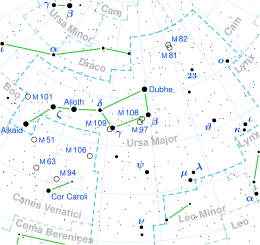Alkor
Videz
(Preusmerjeno s strani 80 UMa)
Lega Alkorja (Mizar je obkrožen, Alkor je v tem merilu neviden) | |
| Opazovalni podatki Epoha J2000.0 Enakonočje J2000.0 | |
|---|---|
| Ozvezdje | Veliki medved |
| Rektascenzija | 13h 25m 13,53783s[1] |
| Deklinacija | +54° 59′ 16,6548″[1] |
| Navidezni sij (V) | +3,99[2] |
| Značilnosti | |
| Spektralni razred | A5Vn[3] / M3-4[4] |
| Astrometrija | |
| Radialna hitrost (Rv) | −9,6[5] km/s |
| Paralaksa (π) | 39,91 ± 0.13[1] mas |
| Oddaljenost | pribl. 80 sv. l. (pribl. 25 pc) |
| Absolutni izsev (MV) | +2,00[2] |
| Podrobnosti | |
| Alcor A | |
| Masa | 1,84[6] M☉ |
| Polmer | 1,846[7] R☉ |
| Izsev | 14,03[6] L☉ |
| Površinska težnost (log g) | 4,25[8] cgs |
| Temperatura | 8.221[8] K |
| Tirna hitrost(v sin i) | 228[6] km/s |
| Alcor B | |
| Masa | 0,25[4] M☉ |
| Starost | 0,5 ± 0,1[2] Ga |
| Druge oznake | |
| Sklici na podatkovne baze | |
| SIMBAD | podatki |

Alkor (Alcor, Saidak) je zvezda v bližini Mizarja. Imenujemo jo tudi Jahač in 80 Velikega medveda (80 UMa, 80 Ursae Majoris).
Ima navidezni sij 4,02m in sodi v spektralni razred A5 V. Spada me najbolj znane navidezne dvojne zvezde, čeprav še ni natančno znano ali res ne tvori pravega dvozvezdja z Mizarjem.
Sklici
[uredi | uredi kodo]- ↑ 1,0 1,1 1,2 van Leeuwen, F. (november 2007). »Validation of the new Hipparcos reduction«. Astronomy and Astrophysics. 474 (2): 653–664. arXiv:0708.1752. Bibcode:2007A&A...474..653V. doi:10.1051/0004-6361:20078357.
{{navedi časopis}}: Vzdrževanje CS1: samodejni prevod datuma (povezava) - ↑ 2,0 2,1 2,2 Mamajek, Eric E.; Kenworthy, Matthew A.; Hinz, Philip M.; Meyer, Michael R. (2010). »Discovery of a Faint Companion to Alcor Using MMT/AO 5 μm Imaging«. The Astronomical Journal. 139 (3): 919–925. arXiv:0911.5028. Bibcode:2010AJ....139..919M. doi:10.1088/0004-6256/139/3/919.
- ↑ Gray, R. O; Garrison, R. F (1989). »The late A-type stars - Refined MK classification, confrontation with Stromgren photometry, and the effects of rotation«. Astrophysical Journal Supplement Series. 70: 623. Bibcode:1989ApJS...70..623G. doi:10.1086/191349.
- ↑ 4,0 4,1 Zimmerman, Neil; Oppenheimer, Ben R; Hinkley, Sasha; Brenner, Douglas; Parry, Ian R; Sivaramakrishnan, Anand; Hillenbrand, Lynne; Beichman, Charles; Crepp, Justin R; Vasisht, Gautam; Roberts, Lewis C; Burruss, Rick; King, David L; Soummer, Rémi; Dekany, Richard; Shao, Michael; Bouchez, Antonin; Roberts, Jennifer E; Hunt, Stephanie (2010). »Parallactic Motion for Companion Discovery: An M-Dwarf Orbiting Alcor«. The Astrophysical Journal. 709 (2): 733–740. arXiv:0912.1597. Bibcode:2010ApJ...709..733Z. doi:10.1088/0004-637X/709/2/733.
- ↑ Kidger, Mark R; Martín-Luis, Fabiola (2003). »High-Precision Near-Infrared Photometry of a Large Sample of Bright Stars Visible from the Northern Hemisphere«. The Astronomical Journal. 125 (6): 3311. Bibcode:2003AJ....125.3311K. doi:10.1086/374996.
- ↑ 6,0 6,1 6,2 Zorec, J; Royer, F (2012). »Rotational velocities of A-type stars. IV. Evolution of rotational velocities«. Astronomy & Astrophysics. 537: A120. arXiv:1201.2052. Bibcode:2012A&A...537A.120Z. doi:10.1051/0004-6361/201117691.
- ↑ Jones, Jeremy; White, R. J; Boyajian, T; Schaefer, G; Baines, E; Ireland, M; Patience, J; Ten Brummelaar, T; McAlister, H; Ridgway, S. T; Sturmann, J; Sturmann, L; Turner, N; Farrington, C; Goldfinger, P. J (2015). »The Ages of A-Stars. I. Interferometric Observations and Age Estimates for Stars in the Ursa Major Moving Group«. The Astrophysical Journal. 813: 58. arXiv:1508.05643. Bibcode:2015ApJ...813...58J. doi:10.1088/0004-637X/813/1/58.
- ↑ 8,0 8,1 David, Trevor J; Hillenbrand, Lynne A (2015). »The Ages of Early-type Stars: Strömgren Photometric Methods Calibrated, Validated, Tested, and Applied to Hosts and Prospective Hosts of Directly Imaged Exoplanets«. The Astrophysical Journal. 804 (2): 146. arXiv:1501.03154. Bibcode:2015ApJ...804..146D. doi:10.1088/0004-637X/804/2/146.

